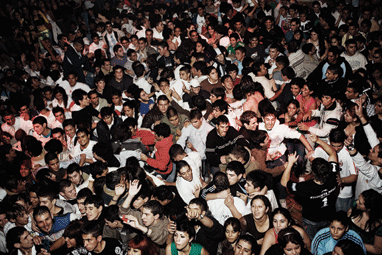Cumbia villera (translated as 'cumbia from the ghettos), a form of digital cumbia, emerged from the poor working class ghettos of an Argentina in the midst of an economic crisis. Played on electronic instruments and often having lewd, political and drug related rapping over its rhythm, cumbia villera became the rough sound of the street until the economic crisis came to a head in 2001/2.
 A Cumbia villera crowd (source)
A Cumbia villera crowd (source)In the aftermath of the Argentinean economic collapse, cumbia villera has made a comeback and is now being played by young urban hipsters around the country. The music of the downtrodden now gained more mainstream acceptance, and as a result there has been a flourishing of digital and experimental cumbia in Argentina.
You can hear some cumbia villera songs on the first the #1, #5 & #6 DJ mixes in the Sounds page.
A neat summary of the cultural factors at play in the spread of cumbia in Argentina are explored in an interview with Dick Verdult, a Dutch DJ who is known as the godfather of experimental cumbia;
I: Speaking of cumbia, it seems that even today the genre still has kind of a stigma as being a kind of lower-class music. It that something you still find as you go around Latin America?
DV: It’s much less. If you take a look at Argentina, the most spoiled kids are playing cumbia villera. It’s already being taken out of the ghettos where it was born. Colombia is authentically a cumbia country and even the prime minister will dance a cumbia without thinking that he is politically correct. He just does what he always did. In Mexico the cumbia is slightly lower class, but it’s accepted. When I came here the first time, people were complaining about cumbia villera. If a car stopped and cumbia was coming out of the windows, it was proof that society was going down. That’s the way they talked about it. I think the cumbia was most stigmatized here. This was the country where cumbia was most pushed down.
I: Why do you think that was?
DV: Argentina is a country that could believe that (it is) slightly European. They’ve got it embedded and only now after the whole crisis are they starting to look really inward. There are a lot of middle class and white people in Buenos Aires, so they have a big necessity to distance (themselves from) the working class…In Peru and Colombia it’s much more mixed.
I: Would you say the changing perception in Argentina is mostly to do with the effect of the economic crisis?
DV: I think that the economic crisis helped a lot to gain interest (in) the interior of the country. Buenos Aires is a port and it looks upward. It doesn’t look inside. It’s not 300 kilometers inside a country like Mexico City. It’s at the edge. (After the crisis), they had to find a cheaper way to do their trips and suddenly they started to look at the provinces. I think that’s a very strong element. And they certainly got an incredible cathartic blow during the crisis. It was like waking up again.
-------------------------------------------------

